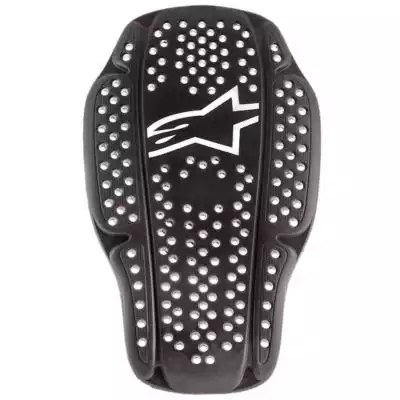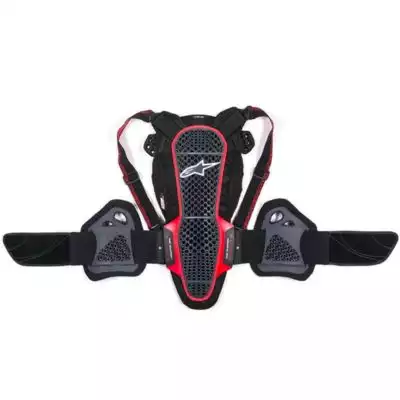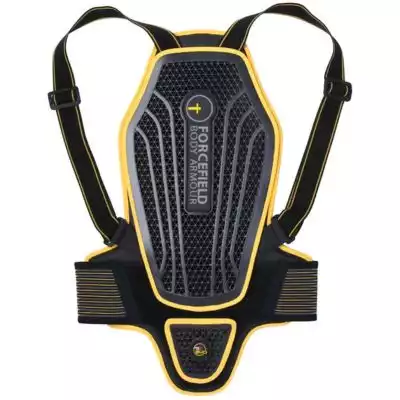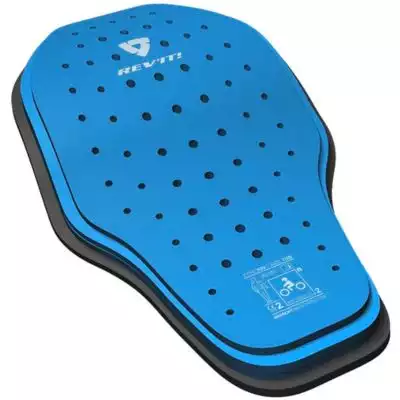If you look at most riding jackets these days, elbow and shoulder armor seem to be a given, but where’s the back protection? Frankly, while I love my elbows and shoulders, I consider my spine even more important.
As a result, I’m always in the market for a great back protector to insert into my jacket or wear on its own. Keep reading to see my list and reviews of the best motorcycle back protectors.
Best Motorcycle Back Protectors – Quick Picks
Alpinestars Nucleon KR-2i Insert: Best insert
Alpinestars Nucleon KR-3 Back Protector: Best standalone
Icon D30 Viper 2 Back Protector: Best budget option
Forcefield Back Protector Pro L2 EVO: Best for comfort
REV’IT! Seesoft Back Protector Insert: Several sizing options
Motorcycle Back Protector Reviews
Alpinestars Nucleon KR-2i Black Protector Insert
I love Alpinestars gear in general, so I wasn’t surprised that it also makes the best back protector. Most importantly, it has CE Level 2 certification, so it meets the highest standards for armor protection. Plus, its contoured fit keeps it fixed to the most vulnerable part of your back, even in the chaos of an accident.
This contoured fit makes it comfortable regardless of your bike’s riding position. Additionally, it’s comfortable even when it gets hot, thanks to its perforated design and integrated ventilation system. This all encourages airflow so you don’t build up heat and sweat in your lower back. With the right jacket, it doesn’t even feel like you’re wearing a back protector at all.
I really like that Alpinestars specifies sizes for both men’s and women’s jackets. A lot of times, female riders just have to adapt to men’s motorcycle products, so this is an inclusive and convenient feature.
Pros:
- CE Level 2 armor
- Adaptive, contoured fit
- Perforated design
- Channel ventilation
- Men’s and women’s sizing
- Lightweight
Cons:
- Only three sizes
Alpinestars Nucleon KR-3 Back Protector
No surprise, my favorite stand-alone back protector is also from Alpinestars. Like the Nucleon insert, it achieves a CE Level 2 rating and provides great protection for your spine, as well as your shoulder blades, thanks to padding extensions.
I like how comprehensive this unit is. While it only comes with the back and shoulder-blade protectors, you can add on a chest protector and coccyx protector if you buy them separately. The downside is that as such a full unit, it can be a bit thick and hard to get under other gear.
The most important aspect of a stand-alone back protector is its fit. It should be secure but comfortable and stay in place over vulnerable areas. The Nucleon KR-3 definitely does that.
It has a full, vented kidney belt with waist adjustment, so you can get it just right. The shoulder straps are adjustable, as well, and the entire design is ergonomic and adapts to the shape of your body.
Pros:
- CE Level 2 armor
- Shoulder-blade protection
- Compatible with chest and coccyx protectors
- Kidney belt
- Strap adjustment
- Ergonomic fit
Cons:
- Bulky
Icon D30 Viper 2 Back Protector
The Icon D30 Viper 2 is my budget recommendation. It’s admittedly pretty basic, but it still provides CE Level 2 protection. Plus, it fits into the vast majority of men’s motorcycle jackets, assuming they have a pocket for a back protector.
As for comfort, it’s perforated for airflow, so while it is on the heavy side, it’s not too hot. It’s flexible as well, so it works for a lot of body types and riding positions.
Pros:
- Affordable price
- CE Level 2 armor
- Versatile fit
- Perforated airflow
Cons:
- Heavy
- Only two sizes
- Only for men’s jackets
Forcefield Back Protector Pro L2 EVO
The Forcefield Pro L2 is another stand-alone back protector that I really love. Its main claim to fame is the Kevlar thread, which gives even the parts without armor considerable strength. Altogether, it has a CE Level 2 rating for protection.
It’s also a highly breathable model thanks to multiple perforations and a layered design. It’s lightweight, and you can adjust it at the shoulder straps and waist to fit it comfortably on your back.
In fact, the Pro L2 is one of the best back protectors when it comes to adapting to your form and movements. This is because the multiple layers can actually move against each other and shift, all while keeping the armor where it counts. It’s definitely a good back protector for racing, motocross, or any riding that requires a lot of movement.
Pros:
- Kevlar thread
- CE Level 2 armor
- Perforated airflow
- Shifting layers
- Adjustability
Cons:
- Only three sizes
- No add-ons
REV’IT! Seesoft Back Protector Insert
If you’re having trouble finding a back protector insert that fits into your jacket correctly, take a look at the Seesoft. Unlike more limited options, it’s available in multiple different sizes.
Getting the correct size makes it that much easier to take advantage of the armor’s protection, which is rated CE Level 2. Its layered design makes it one of the best protectors when it comes to angular impacts since it disperses the energy over a larger area and absorbs the shock.
Unfortunately, the Seesoft works best with REV’IT! jackets, but check the size chart and see if one of the many sizes will work for your jacket.
Pros:
- Multiple sizes
- CE Level 2 armor
- Layered design
- Perforated airflow
Cons:
- Specifically for REV’IT! jackets
- Poor ventilation
Buyer’s Guide
Back Protector Insert vs Stand-Alone Back Protector
My list includes both back protector inserts and stand-alone back protectors. The difference is that an insert is used with some other type of gear, usually a motorcycle jacket that has a pocket for a back protector. Meanwhile, you can wear a stand-alone back protector by itself without other gear.
If you’re going to be wearing an armored motorcycle jacket anyway, it makes more sense to just get an insert. They’re cheaper and a bit more versatile.
On the other hand, if you want back protection but don’t plan on always wearing a jacket, consider a stand-alone back protector. Perhaps it’s the summer and you just don’t want to wear a thick jacket, or you’re hitting the track and your track suit doesn’t have a built-in back protector.
Stand-alone back protectors give you this versatility because you can often still put them on under other jackets or suits. However, you do have to pay a bit more for this convenience.
Protection and Safety Ratings
When buying any kind of back protector, the first thing to look at is its safety rating.
The easiest way to evaluate a back protector’s safety is to check the CE rating. CE is an abbreviation for “Conformité Européene,” which is French for “European Conformity.” This is the standard set by the EU for motorcycle gear, and it’s also sometimes listed as EN.
CE ratings have two levels:
- CE Level 1: The minimum required for most racetracks, at least in the EU, this rating represents protectors that transmit no more than 18 kN of force to the body.
- CE Level 2: This represents even more protection, and it’s required for some high-speed track schools and races. Armor with this rating transmits no more than 9 kN of force.
All the back protectors on my list are CE Level 2, meaning they meet the highest standards of protection.
Sizing and Compatibility
This is something you have to really be careful about when buying a back protector, especially if it’s an insert. A lot of inserts are only compatible with jackets from the same manufacturer and vice versa, so if you get the wrong one, it won’t fit.
Even if a jacket does accept an insert from another brand, you have to check the size, which will be based on measurements provided in the manufacturer’s sizing chart and guidelines. If you get the wrong size, it either won’t fit or it will slide around and fail to provide adequate protection in an accident.
This isn’t quite as big of an issue with stand-alone back protectors, but you should still check that you get the right size if they have multiple options. Also check compatibility with future add-ons in case you’d like to attach other protectors in the future.
Ventilation
Armor can get quite hot in the summer, so most manufacturers include ventilation with their back protectors. This usually comes in the form of dozens of perforations in the protector itself, which allow air to pass through and wick sweat off your body. I recommend looking for this feature.
Read about the best motorcycle jacket for summer riding
Overall Comfort
Once you’re convinced a back protector is safe, you should also verify that it’s comfortable. After all, that will make you more likely to wear it.
Besides ventilation, one of the biggest factors in back-protector comfort is adjustability. This isn’t much of an issue for inserts, but stand-alone back protectors should have straps that you can loosen or tighten. This way, you can make it secure and snug without being so tight that it digs into your skin.
Another factor is the weight. A lightweight back protector is better not only because it’s less tiresome to carry on your back but also because it won’t be as hot during the summer months.
Final Thoughts
Back protectors are often-overlooked pieces of motorcycle gear that really shouldn’t be. If you want to beef up your riding jacket and give your spine some extra protection, I highly recommend the Alpinestars Nucleon KR-2i insert. If you don’t have a jacket and just want a stand-alone back protector, go for the Nucleon KR-3, also from Alpinestars.



